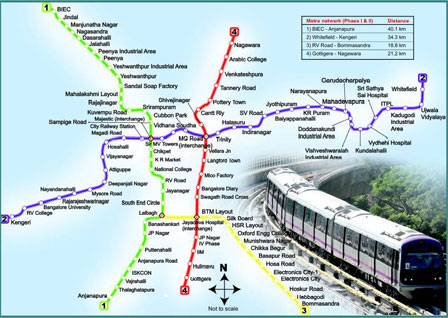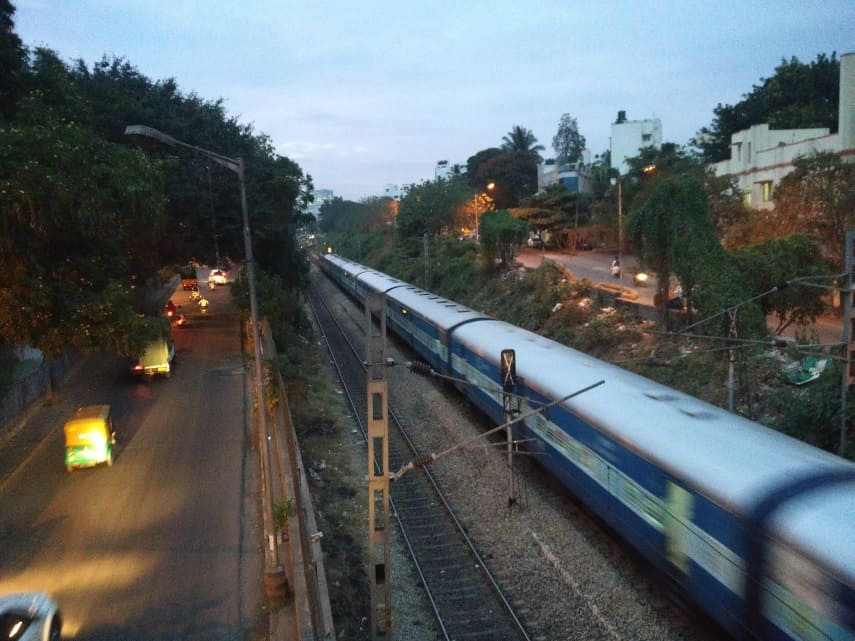This is the second of a three-part analysis of various mobility policies/plans for Bangalore that aim to regulate use of private vehicles to reduce road traffic congestion, improve different modes of public transport and encourage its use, and create the right infrastructure to enable and encourage safe use of non-motorised transport, particularly cycling and walking.
The only way to regulate and reduce the use of private vehicles is for the city to provide different modes of affordable and efficient public transport. Ensuring availability of quality public transport services and non-motorised transport (NMT) infrastructure finds prominent mention in the approved Comprehensive Mobility Plan (CMP, clause 4.6.vii). But as usual, implementation has been patchy.
The principal public transport options are: Namma Metro, Suburban Rail and BMTC.
Metro: fast and comfortable mode of public transport
This is undoubtedly a fast, comfortable and hence an attractive mode of public transport. Users of Bengaluru metro, which has ambitious expansion plans covering many far-flung parts of the city, have been happy with its service.
However, has the Metro been able to fulfil its promise and potential? The answer can be found in media reports published in October/November 2021 when Bengaluru Metro completed 10 years of operations.
As Deccan Herald stated, “Billed as the ultimate panacea for Bengaluru’s infamous road traffic woes, Namma Metro had chugged in with much promise on October 20, 2011. Ten years later, with only two lines and 56.1 kms operationalised, the glitzy mass transport option is now trying to breeze past a maze of missed deadlines and escalating costs, as other cities across India are racing ahead.”
In the Hindu article, Urban mobility expert Dr Ashish Verma has been quoted saying that Namma Metro will remain a key element of a sustainable mobility plan for Bengaluru. “However, its 10-year journey throws up a lot of possibilities for improvement on all aspects. This includes better and integrated planning of corridor alignments and stations, timely execution and completion, speedy network expansion, minimising ecological impacts (lakes, trees etc.) at the planning stage itself, and increasing the supply of services (frequency, train capacity, reliability etc.).”
The News Minute reported that a decade into its functioning however, if one were to evaluate the Namma Metro’s performance, some would argue that it is becoming a white elephant – its costs overwhelmingly outweighing its benefits. While the high costs were expected, especially when compared to the existing bus system, the metro is failing to live up to its billing, and is also falling short of resulting in a significant drop in road congestion due to its planning and operations, said the report.
Part 1: Need parking fees, congestion tax to regulate private vehicles
Part 3: Better mobility design can encourage the use of public transport, cycling and walking
The metro is capable of taking a large number of private vehicles off the roads. In the Detailed Project Reports (DPRs) of Bengaluru Metro phases 2A and 2B, it is mentioned that one of the economic benefits of the project is reduction in traffic congestion.
Again, implementation is the key if Namma Metro is to achieve its enormous potential.

Read more: Need parking fees, congestion tax to regulate private vehicles
Suburban Rail: affordable, efficient mode of public transport
The DPR of the Bengaluru Suburban Rail says that one of the benefits of the project would be congestion reduction due to modal shifts leading to fewer vehicles on roads.
Four corridors of the Bengaluru suburban rail project were approved by the Central government in October 2020. The project is to be completed within six years with the airport corridor to be completed by October 2023.
More importantly, the state government lowered the priority of the airport corridor which will now be taken up in phase 2. This decision goes against what has been specified in the Sanction Letter, and against the advice from the state government’s own Directorate of Urban Land Transport (DULT).
Flying is no longer a luxury.. Suburban Rail would have provided an affordable, convenient and efficient alternative on a route to the airport which is serviced at present entirely by road transport (predominantly cars and taxis).
The decision to lower the priority raises serious doubts about the government’s commitment to reduce private vehicles and provide multiple commuting options to all sections of the society.
The authorities must ensure completion of suburban rail corridors as per their approved priority.

Read more: BMTC buses, schedules lower than pre-second wave levels
BMTC: the only ubiquitous public transport
Bengaluru Metropolitan Transport Corporation (BMTC) is the largest city bus service in India with a fleet of about 6500 buses. At one time, it was the only profit-making city transport system. BMTC still carries 25-30 lakh passengers per day. But due to multiple problems, it is unable to play its role to reduce private vehicles, particularly two wheelers.
Some of the factors responsible for BMTC’s poor health are:
- Congestion: Ironically, BMTC has itself been a victim of road traffic congestion. The average speed of BMTC buses was 16 kmph in 2018, down from 18 kmph in 2016 and 20 kmph a few years earlier.
- Frequent management changes: BMTC has got six MDs in the last four years. As a result, the quality of governance has suffered.
- Delayed Decision making: In 2019, BMTC lost about 75-crore worth subsidies after they failed to induct electric buses before the deadline under FAME-1 scheme (Faster Adoption and Manufacturing of Hybrid and Electric Vehicles)
- Depleting fleet: Available data from BMTC website up to December 2019 shows that the number of buses has come down from 6677 in 2017-18 to 6460 in 2019-20. Media reports indicate that no new buses have been added in the last 2.5 years.
- Unchanged fare structure: Despite steep increases in operational cost, BMTC has not been able to revise its fare since 2014.
- Strained finances: BMTC was unable to pay salary to its staff in April-May 2021 due to its precarious financial situation. It has become highly dependent on the state government.
It will take a long time for BMTC to regain its position as the prime mode of public transport capable of making a dent on the city’s congestion problem. Some positive signs are, however, visible.
- In December 2021, 40 electric buses and 150 BS-VI buses were added to the BMTC fleet and 50 more electric buses are expected soon.
- It was announced that in 2022, BMTC will deploy 1,000 mini-buses, each with a capacity of 20 seats.
Considering the key role played by BMTC, one hopes that the government strengthens and modernises the infrastructure and services of BMTC on a priority basis.
Making Public Transport popular Will make Namma Bengaluru very much more attractive and decongested. The City Will become More vibrant.